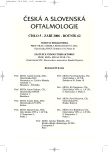-
Medical journals
- Career
The Use of Accommodative Lenses for Surgical Correction of the Presbyopia Using the Prelex Method
Authors: J. Urminský; P. Rozsíval; V. Lorencová; A. Feuermannová
Authors‘ workplace: Oční klinika LF UK a FN, Hradec Králové přednosta prof. MUDr. Pavel Rozsíval, CSc.
Published in: Čes. a slov. Oftal., 62, 2006, No. 5, p. 324-333
Overview
The authors refer about their experience with the surgical correction of the presbyopia by means of the Prelex (presbyopic lens exchange) method.
Patients, who underwent this type of refractive surgery procedure to decrease their dependency on glasses correction for far as well as for near vision (12 patients, 23 eyes) and 1 young female patient (2 eyes) with juvenile cataract and high hyperopia, were included in the study. The average age at the time of the surgery was 51.0 ± 5.5 years (range, 19–77 years). The average follow up period of the whole group of patients is 9.8 months (range, 1–13 months).
Depending on the type of the lens implanted, the group was divided into subgroup A with the accommodative lens 1 CU produced by Human Optics Company implanted, and subgroup B with the accommodative lens Kellan TetraFlex KH 3500 produced by LensTec Company implanted. The subgroup A consists of 8 patients (15 eyes) with the average preoperative refractive error +2.35 ± 3.45 diopters. The average uncorrected visual acuity of this group was 0.24 ± 0.18, and the average best-corrected visual acuity was 0.77 ± 0.22 at the time before the surgery. The average glasses correction for near was +4.1 dioptres, and the uncorrected vision for near was Jaeger’s table Nr. (J) 13.
The B subgroup consists of 5 patients (10 eyes). The average preoperative refractive error was +2.23 ± 0.93 diopters. The average value of the uncorrected visual acuity before the surgery was 0.43 ± 0.28, and the average corrected visual acuity was 0.82 ± 0.25. The average value of the glasses correction for near was +5.25 and uncorrected vision for near J 13.
The final average postoperative error at the time of the last visit was in the A subgroup +0.06 ±1.17 dioptres. The average uncorrected visual acuity was 0.69 ± 0.24, and the average best-corrected visual acuity 0.96 ± 0.12. The average vision of the patients of this subgroup for near was J 3.
In the B subgroup we found at the last visit the average final value of the postoperative refractive error –0.2 ± 0.72 dioptres. The average uncorrected visual acuity 0.57 ± 0.22 and the average corrected visual acuity 0.95 ± 0.12. Average uncorrected vision for near was J 5.We did not notice any serious per - or postoperative complication of this procedure.
Key words:
presbyopia, accommodation, Prelex, 1 CU, Kellan Tetraflex KH 3500
Labels
Ophthalmology
Article was published inCzech and Slovak Ophthalmology

2006 Issue 5-
All articles in this issue
- Ocular Symptoms as an Indication for Carotid Endarterectomy
- The Human Lens’ Transparence Changes in Children, Adolescents, and Young Adults with Diabetes Mellitus Type I
- Clinical Appearance and Outcome of Zone 1 ROP
- The Use of Accommodative Lenses for Surgical Correction of the Presbyopia Using the Prelex Method
- The Quality of Vision in Premature Infants – First Results
- The Color Doppler Ultrasonography in Glaucoma Diagnosis
- The Influence of Corneal Thickness on Level of Intraocular Pressure in the Group of Healthy Persons and Patients with Primary Open Angle Glaucoma (POAG)
- Czech and Slovak Ophthalmology
- Journal archive
- Current issue
- Online only
- About the journal
Most read in this issue- The Use of Accommodative Lenses for Surgical Correction of the Presbyopia Using the Prelex Method
- Ocular Symptoms as an Indication for Carotid Endarterectomy
- Clinical Appearance and Outcome of Zone 1 ROP
- The Quality of Vision in Premature Infants – First Results
Login#ADS_BOTTOM_SCRIPTS#Forgotten passwordEnter the email address that you registered with. We will send you instructions on how to set a new password.
- Career

